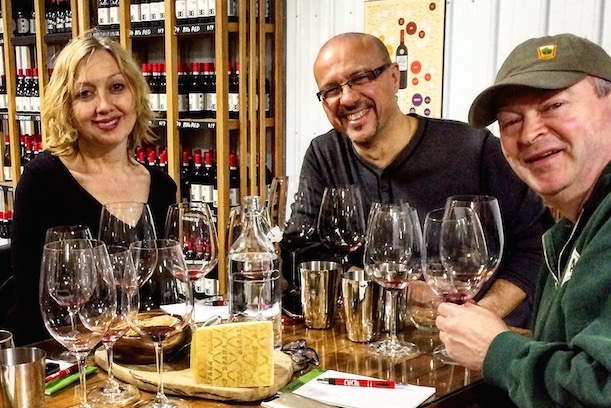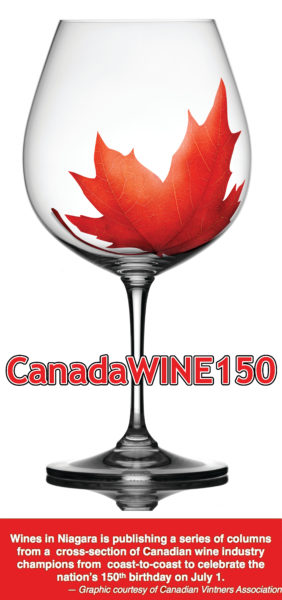
By Jeffrey Pinhey
HALIFAX — The lifestyles and type of communities that evolve in wine growing regions connect people to the land, now perhaps more than at any time in our lives.
Current socioeconomic movements associated with eating local food correspond to the move back to the land, and attention to the concept of terroir, that is happening in the wine world.
Note: For previous columns on CanadaWINE150 go here
 As Canadians seek to improve our status in the greater wine world, there is a growing desire from winemakers and grape growers to express the basic elements of place in their wine. The industry is evolving from what was once a “factory product” to an agricultural one, and it is fair to say that most wine lovers think this is a good thing.
As Canadians seek to improve our status in the greater wine world, there is a growing desire from winemakers and grape growers to express the basic elements of place in their wine. The industry is evolving from what was once a “factory product” to an agricultural one, and it is fair to say that most wine lovers think this is a good thing.
Wine is slowly changing from a manufactured product to be consumed as a branded beverage, to one that is grown and carefully shepherded into a fine, value added elegant beverage. This process can be looked at as going back in time, back to the roots of early viticulture.
When a farmer grew food, some of that product could be used to make drink that would not spoil quickly, could be consumed with a meal, and, when taken in enough quantity, would make your cares and troubles seem less significant, at least until the next morning. They didn’t care if the alcohol came from grapes, apples, or malted grains.That this retreat to a more direct connection to the land is happening in the wine industry is not really news to most people who follow the industry. What may surprise some is how this is also occurring in the beer, cider, and mead making boom that Canada is currently experiencing.
Last month I had a glass of a beer made by Big Spruce Brewing in Nyanza, Cape Breton, called “The One Hundred.” This name had nothing to do with IBU’s or alcohol — it stood for 100% — the beer was made completely from ingredients grown or found in Nova Scotia.
The brewery used organic barley from TapRoot Farms in Port Williams and organic rye from Stewart’s Organic Farm, malted at Horton Ridge Malt & Grain Company. The hops were from the brewery’s own organic hop farm, and the yeast was isolated from a wild cherry tree near the brewery. The brewery has its own well.
This beer shows obvious characteristics from the yeast, and absolutely expressed unique characteristics that could be related to the concept of terroir.

Although this might seem somewhat extreme to your typical factory beer drinker, it is not such an unusual thing any more in the production of beer. Many breweries around the globe are making a beer they tend to lump into a “Farmhouse” style; beer from their own place, as much as they can.
Most beer consumed in the world (and probably most wine) is produced in what are essentially factories, to be a consistent product with significant attention and money spent on the outside of the bottle. Now we are seeing wines and beers that are returning to their roots, back to a time when the place where things were grown determined what could and could not be made, and how it tasted.
One of the key principles associated with Landscape Ecology can be described as the energy of the edge. The idea that where there is a transition in nature, from shoreline to ocean or from meadow to forest, for example, nature is most productive. Another type of edge is climatic, where a tenuous line between where something can survive, and where it cannot, exists. At that edge, great things can happen.
We see this in Canada now in the wines we make. How great a Syrah can be when it manages to survive the winter, how intense a sparkling wine can be when it receives a long, cool ripening autumn, achieving complete phenolic ripeness at low sugar levels. Indeed, wines made on the edges of terroir in traditionally famous wine growing regions are often the best.
We should stop thinking of our risk laden climate as a negative thing, and start viewing it for what it is, the means whereby we can craft the very best. Changes in climate are shifting these lines, turning places like Champagne into places that can now make still wine with ripe grapes — presumably Champagne became a sparkling region because they historically could not get 22 Brix every year to make still wine.
Except for the brand recognition of the region, and the fact that some people will still pay hundreds of dollars for a bottle of wine from there, they might be better off bottling Chardonnay and Pinot Noir as still wine. If they were starting from scratch, that is.
Beer is also affected by terroir when it is made in place. Farmhouse type ales originated in places where it was usually too cold for wine grapes to ripen, but people still wanted to drink a fermented beverage and enjoy their drink with food. Sour beers are not that far from drinking wine, especially when you enjoy them with food. These both are often fermented (and soured) with microbiological organisms native to the property. They represent beer from the edge, and like the great Canadian wines we cherish, come from a place where failure can be imminent, but success is rewarded.
One of the most exciting things happening in the beer world in Canada today is the amalgamation of wine and beer and spirits to create hybrids.
I recently enjoyed an amazing sour cherry beer that had been aged in a Pinot Noir barrel. The lines that were formed between wine and beer long ago, sometimes attributed to the Roman empire and their insistence on bringing their grape derived beverage along with them, are blurring.
As Canada turns 150 years old, the Canadian beverage industry is slowly returning to its roots, one vineyard, or hopyard, at a time. For those of us who value unique identifiable characteristics that speak of where food or drink originated, that’s a good thing.
About Jeffrey Pinhey

Jeffrey Pinhey is a National Level BJCP Beer Judge and a Member of the Canadian Association of Professional Sommeliers. A Professional Engineer by day, he has judged the Lieutenant Governors Wine Awards for Nova Scotia every year they have been held, and been a final round Best of Show Judge at the Canadian Brewing Awards three times.





Comment here